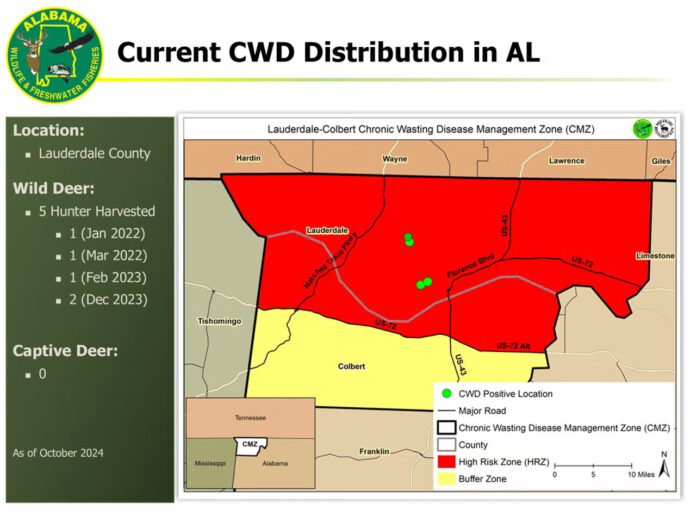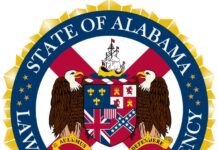In a continuing effort to minimize the spread of chronic wasting disease (CWD) in the state, the Alabama Department of Conservation and Natural Resources’ (ADCNR) Wildlife and Freshwater Fisheries (WFF) Division held this season’s first mandatory CWD check last weekend in Lauderdale County.
WFF staff sampled 356 deer for CWD, a neurodegenerative disease that affects cervids, including white-tailed deer, at the sampling stations in Lauderdale County. In addition to samples from Lauderdale and Colbert counties, the WFF sampling stations typically collect samples from deer harvested in the nearby counties of Franklin, Lawrence, Madison and Marion as well.
“The success of our CWD Management Program is dependent on hunter participation,” said WFF Director Chuck Sykes. “We appreciate the support we’ve gotten in past seasons.”
WFF has also added a new dedicated staff position to specifically deal with wildlife diseases. Olivia Sciandra was hired this year as the Wildlife Health Program Coordinator in the WFF’s Wildlife Section and will head up the ongoing CWD sampling efforts.
“In total, what we got this past weekend was outstanding,” Sciandra said. “Gratefully, we had an opening weekend of good weather.”
Last weekend was the first of three mandatory weekends in the CWD Management Zone (CMZ), which is divided into the High-Risk Zone (HRZ) and Buffer Zone (see www.outdooralabama.com/cwd/cwd-zone-map). The second mandatory sampling weekend in the HRZ is December 7-8, 2024, while the third mandatory weekend is in the Buffer Zone and will take place January 11-12, 2025.
“Unfortunately, wildlife diseases are a growing issue that state agencies across the country are dealing with,” Sykes said. “Alabama is no exception. From CWD in white-tailed deer to avian influenza to white-nose syndrome in bats, the disease ecologist position is vital to our agency’s success now and in the future.”
Sciandra added, “Our goals remain the same as far as how many samples we get from each county. Sampling had already begun with the opening of archery season and now with the opening weekend of gun deer season. We now have five deer total that have been confirmed with CWD, four bucks and one doe. All of them have been in Lauderdale County.”
The most recent CWD positive tests were confirmed in two deer in December 2023. After the first deer with CWD was confirmed in January 2022, an emergency regulation was signed to establish the CMZ in Lauderdale and Colbert counties. Since then, the HRZ was expanded to include all of Lauderdale County. Carcass restrictions were also put in place that prohibit the transport of deer carcasses and deer parts in the CMZ. Deer harvested in the HRZ must remain in the HRZ, and deer harvested in the Buffer Zone must remain in the CMZ.
Other transportation restrictions are in place. Whole carcasses and other parts from the family Cervidae (white-tailed deer, mule deer, elk, moose, fallow deer, red deer, sika deer, caribou, reindeer, etc.) may not be imported/moved into Alabama from any other state, territory, or province unless all meat has been deboned and skull plates and hides have been completely cleaned of all brain and spinal cord tissue.
The following are approved guidelines for the allowable transportation of deer and other cervids from outside the CMZ or another state, territory or province: meat from the cervid family that has been completely deboned; cleaned skull plates with attached antlers, if no visible brain or spinal cord tissue is present; unattached antlers or sheds, raw capes, if no visible brain or spinal cord tissue is present; upper canine teeth, if no root structure or other soft tissue is present; and finished taxidermy products or tanned hides.
Sciandra regularly communicates with wildlife professionals in neighboring states. She said no new CWD cases have been detected in counties bordering Alabama since the road-killed deer in Holmes County in the Florida Panhandle tested positive for CWD in 2023.
“We’re keeping an eye on that area adjacent to Holmes County,” she said. “That is an area in our management plan where we are constantly adapting and increasing our sampling goals in south Alabama.”
Since she has been with WFF, Sciandra has been able to conduct seminars as well as interact with the public and field phone calls in her office.
“The people I’ve been able to talk to are just wanting to make sure they are aware of our regulations and rules in the CMZ,” she said. “I’m seeing a lot of people excited about getting out and hunting. That’s what we want to see is people hunting, not being scared about CWD, but being aware of the regulations and the testing we have available to hunters.”
Supplemental wildlife feeding and baiting privileges have been suspended within all of Colbert and Lauderdale counties. The suspension of supplemental feeding will not apply to bird feeders within 100 feet of a building or occupied dwelling or feed inside an active feral hog trap. Supplemental feeding and baiting privileges will still be allowed outside of the CMZ.
For those who don’t process their own deer, hunters can take deer harvested in the HRZ to processors and/or taxidermists only within the HRZ. Hunters can take deer harvested in the Buffer Zone to processors and/or taxidermists located anywhere within the CMZ.
All deer harvested by hunters on public land in the CMZ are required to be sampled throughout the season. Those public lands include the Freedom Hills WMA, Lauderdale WMA, Seven-Mile Island WMA, Cherokee Physically Disabled Hunting Area, and Riverton Community Hunting Area.
Hunters in the rest of the state are urged to voluntarily drop off hunter-harvested deer at the CWD self-service freezer locations. Go to www.outdooralabama.com/cwd/cwd-sampling for more information and an interactive location map. The freezers are available 24/7.
Another disease that affects deer is hemorrhagic disease, but Sciandra said there have been few reports of outbreaks this year.
“Our biologists track hemorrhagic disease cases through public reports,” she said. “Usually, those reports come in from July through October. We’ll be tallying those reports and sending those reports to our regional partners annually. From what we’ve seen, it wasn’t a busy year for hemorrhagic disease.
“In addition to monitoring deer diseases, we’re also working with our partners to do sampling for white-nose syndrome in bats. That’s something we want to ramp up. We’re looking at diseases in our reptiles and amphibians and avian influenza in birds. It’s really anything that could impact the health of wildlife is what we’re building into this program.”



















